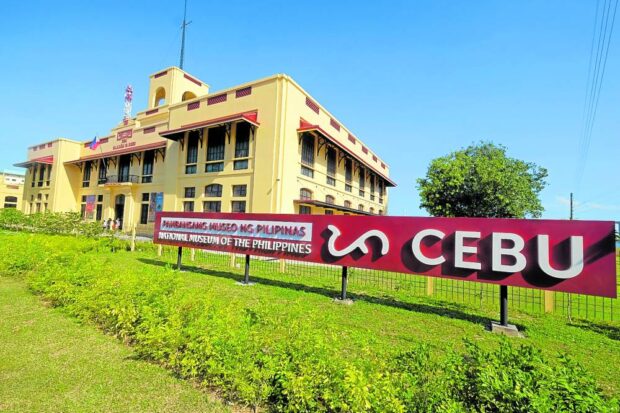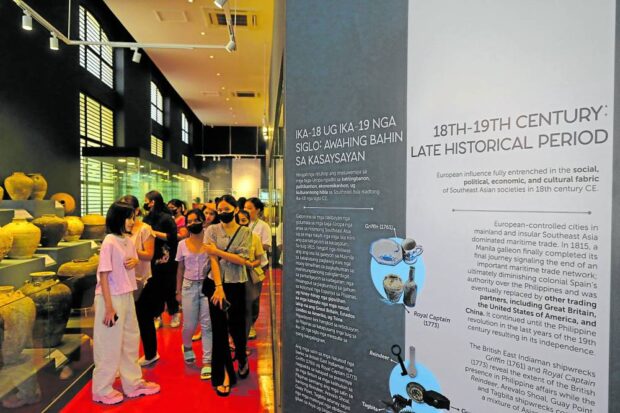Celebrating Cebuano heritage, culture

MAJOR ATTRACTIONS One of the major art pieces at the National Museum of the Philippines in Cebu features the Battle of Mactan in 1521 which depicts local chieftain Lapulapu and his warriors defeating the Spaniards led by Portuguese explorer Ferdinand Magellan. (Photo by EMMANUELLE R. SAWIT)
CEBU CITY, Cebu, Philippines — For 502 years since Spanish explorers and missionaries set foot on the island of Cebu, this city, acknowledged as the oldest in the Philippines, did not have a museum that was funded and maintained by the national government.
But on July 28, the city finally became home to the National Museum of the Philippines in Cebu (NMP-Cebu), the 18th component museum of the NMP system in the country.
The customs house of Cebu City’s port underwent a massive transformation to host the museum and complete the historical triumvirate near the Port of Cebu. This area features Plaza Independencia, the adjacent Fort San Pedro, and, about 200 meters away, the NMP-Cebu.
“The historical building in front of us is meant to serve as such a temple not just for Cebuanos but for Filipinos all over the country and visitors of the world to come to learn about a significant slice of our nation,” said NMP chair Andoni Aboitiz.
President Ferdinand Marcos Jr., who led the inauguration of NMP-Cebu on July 28, hailed the development, saying that museums are considered valuable cultural assets to a nation as they build a sense of community, document history, inspire creativity, promote tourism, and unite people through a shared heritage.
“It is a milestone not only for the Queen City of the South and the whole province of Cebu but for the entire country as the opening of this museum brings to the fore our rich natural, cultural, and artistic treasures,” the President said during the ceremony.
“If you haven’t been in there, you are in for a special treat. The exhibits that have been put out, the way that they have been presented, the curation of the different artifacts has been done in such a splendid fashion that it would require perhaps a week of coming here every day to properly see it,” Marcos added.
The President toured the museum along with local and other national officials after he led the ceremonial ribbon cutting and unveiling of the museum’s marker. With the President were first lady Marie Louise “Liza” Araneta-Marcos, Tourism Secretary Maria Christina Garcia-Frasco, Cebu Gov. Gwendolyn Garcia, and Cebu City Mayor Michael Rama.
Aboitiz said the budget for the museum reached about P250 million, which was used for structural work, renovation and other preparations over a period of four years.

HOLY CHILD | Artworks showing different renditions of the revered Sto. Niño, a Cebu icon, always attract children and their families. (Photo by EMMANUELLE R. SAWIT)
Overcoming setbacks
But the construction of the NMP-Cebu suffered several setbacks.
One was the COVID-19 pandemic in 2020 and 2021 which slowed down work because of strict health protocols imposed to slow down the spread of the coronavirus.
Then in December 2022, Supertyphoon Odette (international name: Rai) devastated the Visayas and parts of Mindanao and left Cebu with a trail of destruction.
But Marcos said the NMP-Cebu would open its doors to the public due to “shared commitment and dedication” to establishing a national museum in one of the country’s top tourist destinations.
The National Museum in Cebu City started operations on Aug. 1 and will be open from Tuesday to Sunday, from 9 a.m. to 5 p.m. Admission is free.
Cebu City’s national museum is housed at what was once the “Aduana” building designed by American architect William Parsons and built in 1910 to facilitate trade between Cebu island and its neighboring islands. For 94 years, it served as the customs house of the city’s port, surviving even the massive bombings during World War II.
In 2004, then President Gloria Macapagal-Arroyo converted the two-story structure into her official residence in Cebu and named it “Malacañang sa Sugbo” (Malacañang of Cebu).
But the building was closed in October 2013 after it was declared unsafe for occupancy due to the damage it sustained when a magnitude 7.2 earthquake hit Cebu.
In 2019, plans of converting it into a national museum were made public. In the same year, the structure was declared a National Cultural Treasure and was turned over to the NMP for its revival as the third national museum in Central Visayas. The two other national museums in the region operate in Tagbilaran City, the provincial capital of Bohol, and Dumaguete City, the capital of Negros Oriental province.
The NMP entered into a usufruct agreement with the Cebu Port Authority, which owns and manages the property, to turn it into a national museum.
Restoration work was done from 2020 to 2023 with the help of the Tourism Infrastructure and Enterprise Zone Authority.

RICH IN HISTORY | The former Malacañang sa Sugbo, the historic customs house built in 1910, is now home to the National Museum in Cebu City. (Photo by EMMANUELLE R. SAWIT)
Five galleries
The museum features at least five main galleries that highlight Cebu’s geological resources, plant and animal life, archeological discoveries, local arts and history, and ethnography embedded in the island’s trade and culture.
The first gallery contains rare geological features, including some unfamiliar plants and animal species endemic to Cebu like a species of the now-extinct dwarf water buffalo, similar to the tamaraw, whose bones were recovered in Balamban town, in midwest Cebu.
The second gallery, on the other hand, features significant archaeological finds that will further educate visitors about the history of Cebu, and others related to the Philippines.
Among the items found in the second gallery are burial jars, ewers or large jugs with wide mouths formerly used for carrying water for someone to wash in, and a gold death mask that dates back to the 15th century. The vast collection of archaeological artifacts was excavated in the towns of San Remigio and Boljoon as well as in Plaza Independencia in Cebu City.
The third gallery focuses on the exhibit of sustained ethnographic traditions inculcated in maritime history and industry. Among the exhibits here were jars, plates, and some artifacts that were recovered from shipwrecks.
The fourth gallery brings a collection from the Philippine Center in New York to Cebu, featuring artworks of leading Filipino artists in the early 1970s. It houses 92 paintings by 36 artists.
The fifth gallery contains the work of famed Cebuano artist Martino “Tinong” Abellana, called the “Dean of Cebuano Painters.”
The exhibit is made in honor of Abellana’s works, including sketches, portraits, abstract paintings, and landscapes from the Abellana family and private collectors.
People can also enjoy the open terrace, courtyard and museum shop.

Pottery and archeological finds (Photo by EMMANUELLE R. SAWIT)
Long overdue
Mayor Rama said having a national museum in the city was long overdue.
“This is for Cebu and you can imagine it’s a long overdue project that started three years ago. And now it’s a museum. Additional tourism attraction and for our children and the schools too, so that they may be able to see by themselves the soul and the heart of Cebu,” he said.
The museum, he stressed, should be included in school tours.
Vice Mayor Raymond Alvin Garcia, chair of the Cebu City Cultural and Historical Affairs Commission, said: “Cebuanos have been longing for a [national] museum, although we have a few museums here, right and left. A national museum is really different. We are very happy and this will bring so much heritage value, and I’m sure because of this, Cebuanos will be able to identify themselves in their past and our rich history.”
According to Audrey Tomada, head of NMP-Cebu, walk-in visitors are allowed but group activities must be booked in advance. She also asked visitors to follow museum guidelines.
“You have to be dressed appropriately in a way that could not offend anyone. They should not touch any of the objects that are openly displayed. Photography is allowed, but without flash, and in some areas, we allow video. No food is allowed inside the galleries, as well as large backpacks because the museum has no area [to store personal belongings],” Tomada said.
In a press conference on July 31, lawyer Maria Cecilia Tirol, director of NMP’s Visayas Museums, said leasing spaces to businesses could help the museum generate funds.
“Our mandate is to keep our doors open to visitors without any charge,” she said. “We will eventually develop more exhibitions in order for us to connect with Cebu audiences. That’s part of our programs.”